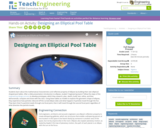
Students analyze the distribution of categorical data. They calculate percents and visually compare the data sets with a bar chart.
- Subject:
- Mathematics
- Material Type:
- Lesson Plan
- Provider:
- Texas Instruments
- Date Added:
- 08/07/2023

Students analyze the distribution of categorical data. They calculate percents and visually compare the data sets with a bar chart.

Students categorize data using tables and bar charts. They also determine relative frequencies.

Students sort data and display it graphically using various plots. They also get familiarized with statistical concepts like measures of spread and central tendency.

In this two-part activity, students design and build a Rube Goldberg machine. The open ended problem uses the engineering design process and can have a preset purpose, such as rolling a marble into a cup from a distance, or can be left for the students to decide.

Students learn about the mathematical characteristics and reflective property of ellipses by building their own elliptical-shaped pool tables. After a slide presentation introduction to ellipses, student “engineering teams” follow the steps of the engineering design process to develop prototypes, which they research, plan, sketch, build, test, refine, and then demonstrate, compare and share with the class. Using these tables as models to explore the geometric shape of ellipses, they experience how particles rebound off the curved ellipse sides and what happens if particles travel through the foci. They learn that if a particle travels through one focal point, then it will travel through the second focal point regardless of what direction the particle travels.

In these questions, students are asked to find the determinant and the inverse of four 2 x 2 matrices. These multiple choice questions have solutions provided.

This set contains questions about statistics involving how to choose a sample size to fit a desired maximum error bound. The student learns to do this on confidence intervals for proportions as well as confidence intervals for means.

Contains plans for two or three lessons that teach searching, skimming, and scanning skills using an internet bingo game that is easily adaptable to a variety of topics. In addition to objectives and standards, this instructional plan contains links to PDF handouts and sites used in the lessons as well as assessment and reflection activities.

This basic graphic design content package is intended to support educators in discovering new resources and lessons for grades 9-12. These resources could also be used to supplement technology and STEM lessons.

This basic digital audio content package is intended to support educators in discovering new resources and lessons for grades 9-12. These resources could also be used to supplement technology and STEM lessons.

Through discussion and hands-on experimentation, students learn about the geological (ancient) carbon cycle. They investigate the role of dinosaurs in the carbon cycle and the eventual storage of carbon in the form of chalk. Students discover how the carbon cycle has been occurring for millions of years and is necessary for life on Earth. Finally, they may extend their knowledge to the concept of global warming and how engineers are working to understand the carbon cycle and reduce harmful CO2 emissions.

This lesson allows students read various sonnets and chart the basic characteristics of the poem, using their observations about traditional sonnet forms. After, students write original sonnets, using one of the poems they have analyzed as a model.

This set contains statistics questions comparing distributions of univariate data. The student is asked to note the differences between distributions regarding center, shape, spread, and existence of outliers.

In this activity, students make use of a visual representation for dividing fractions. They also discover the numerical algorithm used to divide fractions.

Students use StudyCards(tm) to practice completing division equations that include positive and negative integers.

The Supreme Court's landmark opinion overturned its earlier ruling in Plessy v. Ferguson and declared segregated schools unconstitutional.

The Supreme Court's opinion in Brown II reflects the struggle between federal and state governments on how and when school desegregation would occur.

The Civil Rights Act of 1964 helped enforce the Brown ruling, a decade later.

This collection of excerpts from legislation and court decisions documents key phases of the legal struggle to gain and implement equal education.

Ibiblio.org offers links to three documents signed by Germany, Japan, and Italy during World War II.